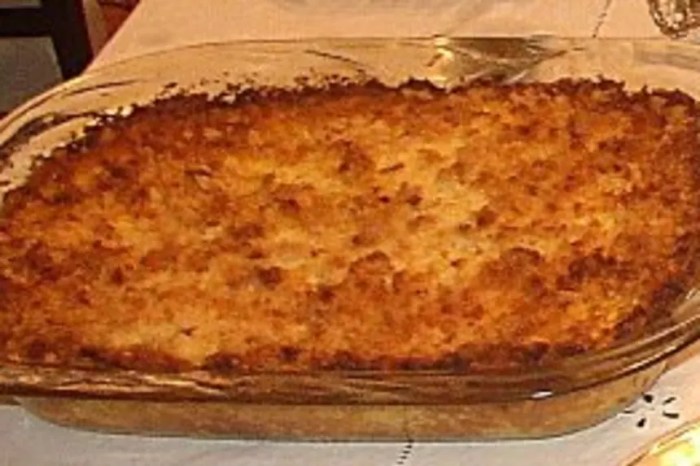Aunt Fannie’s Squash Casserole Recipe, a culinary gem steeped in tradition, beckons us on a gastronomic journey. Its origins, ingredients, and delectable variations will tantalize your taste buds and warm your soul.
This beloved dish, a staple in American cuisine, has graced family tables for generations. Its key ingredients, including tender squash, savory seasonings, and a crispy topping, combine to create a symphony of flavors.
Aunt Fannie’s Squash Casserole Recipe
Aunt Fannie’s Squash Casserole is a classic American comfort food that has been enjoyed by families for generations. This savory dish is made with a combination of cooked squash, bread crumbs, cheese, and seasonings, and is typically baked in a casserole dish until golden brown and bubbly.
Overview of Aunt Fannie’s Squash Casserole Recipe
Aunt Fannie’s Squash Casserole is a simple yet flavorful dish that is perfect for a family meal or holiday gathering. The key ingredients in the casserole are:
- Cooked squash: Butternut squash, acorn squash, or pumpkin can be used.
- Bread crumbs: Fresh or dry bread crumbs can be used.
- Cheese: Sharp cheddar cheese or Parmesan cheese is typically used.
- Seasonings: Salt, pepper, and garlic powder are common seasonings used in the casserole.
These ingredients are combined and baked in a casserole dish until the casserole is set and the top is golden brown.
Step-by-Step Instructions
- Preheat oven to 350 degrees F (175 degrees C).
- Cook the squash: Cut the squash in half, remove the seeds, and bake face down in a baking dish at 400 degrees F (200 degrees C) for 45-60 minutes, or until tender.
- Prepare the bread crumbs: In a large bowl, combine the bread crumbs, cheese, salt, pepper, and garlic powder.
- Combine the ingredients: Scoop the cooked squash out of the skin and add it to the bowl with the bread crumb mixture. Stir until combined.
- Transfer to a casserole dish: Pour the squash mixture into a greased 9×13 inch casserole dish.
- Bake: Bake the casserole in the preheated oven for 30-35 minutes, or until the casserole is set and the top is golden brown.
- Let stand: Let the casserole stand for 10 minutes before serving.
Variations and Adaptations
There are many variations of Aunt Fannie’s Squash Casserole that can be made to suit different tastes and dietary restrictions.
- Different types of squash: Butternut squash, acorn squash, or pumpkin can be used in the casserole.
- Gluten-free: Use gluten-free bread crumbs to make the casserole gluten-free.
- Vegan: Use vegan cheese and bread crumbs to make the casserole vegan.
- Additional ingredients: Diced onions, bell peppers, or corn can be added to the casserole for extra flavor.
Tips and Techniques

- Select the right squash: Choose a squash that is firm and free of bruises.
- Create a crispy topping: Sprinkle the top of the casserole with bread crumbs or grated cheese before baking for a crispy topping.
- Balance the flavors: Taste the casserole before baking and adjust the seasonings as needed.
- Avoid overcooking: The casserole should be baked until set, but not overcooked, as this will make the casserole dry.
Presentation and Serving Suggestions
Aunt Fannie’s Squash Casserole is typically served hot as a main course or side dish. The casserole can be garnished with fresh herbs, such as parsley or chives, or with a dollop of sour cream or yogurt.
Historical and Cultural Significance: Aunt Fannie’s Squash Casserole Recipe
Aunt Fannie’s Squash Casserole is a dish that has been enjoyed by families for generations. The dish is thought to have originated in the United States in the early 1900s, and it has since become a staple of American cuisine.
The casserole is often served at family gatherings and holiday meals, and it is a dish that is associated with comfort and nostalgia.
Clarifying Questions
What is the origin of Aunt Fannie’s Squash Casserole Recipe?
The exact origins are unknown, but it is believed to have originated in the Southern United States in the early 20th century.
Can I use different types of squash in this recipe?
Yes, you can substitute butternut squash, zucchini, or pumpkin for the yellow squash.
How can I make this recipe gluten-free?
Use gluten-free breadcrumbs or crushed crackers as the topping.